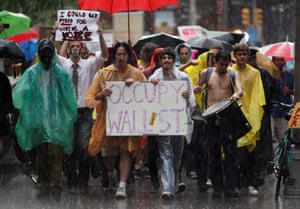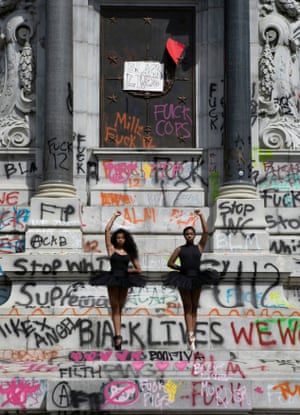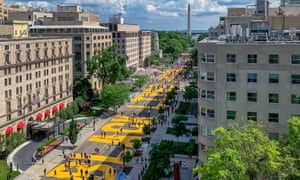After 15 stunning days of anti-racist protests … what happens next?
Can the phenomenal response to the police killing of George Floyd be channeled to secure lasting political change?
- George Floyd killing – latest US updates
by Ed Pilkington
The New Yorker writer Jelani Cobb captured best the sense of wonder at what is happening on the streets of America. He posted a tweet from Mitt Romney, the Republican senator from Utah, which showed the former presidential candidate marching alongside demonstrators under the banner Black Lives Matter.
“Ladies and gentleman,” Cobb remarked. “This is what you call uncharted territory.”
Fifteen days and nights into this nationwide conflagration, the protests following the killing of George Floyd in Minneapolis are truly navigating the unknown.
Enormous crowds, overwhelmingly peaceful and highly diverse, have erupted in cities across the country; a movement against police brutality has been met with police brutality; the US president has responded with one of the most memorable – and violent – photo ops of the modern era.
“The popular reaction to the gruesome Floyd murder has been astonishing in its national scope, fervent commitment and interracial solidarity,” observed the philosopher and social critic Noam Chomsky. “The malignancy that infects the White House has been exposed in all its ugliness.”
But as the demonstrations tear through their third week, with no apparent loss of momentum, the little voice that inevitably arises with all such public outbursts begins to be heard. As it grows louder, the question it poses intensifies: what happens next?
Where does all the energy unleashed by the protests go? What happens to “Defund the police” when the chanting fades? When the day comes – as presumably, eventually, it must – what will be left on the empty streets to show for it?
“Marches are a tactic,” Chomsky told the Guardian. “Not much has emerged about strategy, or even specific articulated goals, beyond major reform of police practices and responsibilities.”
A potential cautionary tale for the present-day protests is offered by Occupy Wall Street. Like the current maelstrom, those protests burst on to the public stage in September 2011 quite unexpectedly, with a thousand or so people cramming themselves into New York City’s Zuccotti Park under the rubric: “We are the 99%.”

Also in an echo of today, the Occupy protesters were met with violent police shutdowns leading to hundreds of arrests. The park was finally brutally cleared two months later.
Nobody could doubt the success of Occupy in changing the nature of the national political and social debate. It put concepts of income inequality, of the “1%”, firmly and permanently on the map.
But once the protest had been broken up, its resolutely anti-hierarchical nature, combined with the distrust of many of its activists towards institutions and infrastructure, meant that it had nowhere else to go. It dissipated into the downtown Manhattan air.
“Occupy was also a tactic, not a strategy, and one that could not continue,” Chomsky said. “It had an impact: focusing on extreme inequality that is poisoning the society under the neoliberal regime. But from that point on other forms of activism have to take over, and to some extent have.”
Nelini Stamp, director of strategy for the Working Families party, is well-placed to comment on the “what next?” conundrum, having been deeply involved in Occupy and now being immersed as an organizer of the George Floyd protests in New York. Though she agrees that Occupy didn’t directly change America – income inequality in the US has increased steadily every year since 2011 – it did spawn a number of powerful campaigns to long-term effect.
She points to the fight for a higher minimum wage and union representation for fast-food workers. She also credits Occupy with giving Vermont’s socialist senator Bernie Sanders the opening through which he burst on to the stage as a presidential candidate – twice.

“We created the space so that Bernie could do his run in 2016 and 2020, and for Elizabeth Warren running for president with her economic populist message.”
Stamp disagrees with Chomsky that the current wave of protests has failed to articulate a specific way forward. “I think the demands have been fairly clear: defunding police, reimagining public safety, and we are slowly winning.”
Certainly, today’s protesters can point to the first blossoming of change on a local level. The city council in Minneapolis, where the 46-year-old African American was killed by police on 25 May, has voted to disband the police department and start over.
New York city lawmakers have moved to ban the use of chokeholds of the sort that killed Eric Garner. The Portland police chief is resigning amid calls for “bold reform”, and on a national level, Democrats who control the House of Representatives have unveiled the most ambitious plan for law enforcement reform in years.
In perhaps the most aesthetically pleasing signal of change, a street within spitting distance of Donald Trump in the White House has been renamed “Black Lives Matter Plaza”.
In the grand scheme of things, these individual victories may amount to no more than pointillist dots on the vast canvas of America’s woes. But to the protesters they are vital oxygen.
“To maintain activism on the streets you need little successes,” said Dana R Fisher, a professor of sociology specializing in protest movements at the University of Maryland. “Think about the civil rights movement – it was a long, arduous, painful process to get the black vote, but it was sustained by these little successes along the way.”
Fisher believes that the huge sweep of protests in more than 750 cities and towns all across America holds out a golden opportunity for dramatic change to be achieved through the ballot box in November. Her recent book, American Resistance, tracked the impact of the 2017 Women’s March held the day after Trump’s inauguration.
Studying the data, she found that much of the energy released on that day – the largest day of protest in American history – was channeled back into local communities and their congressional races. The result was that Democrats took back the House in 2018 in the so-called “Blue Wave”.

She sees a repeat of that potential today. “We are seeing amazing opportunities for people to channel what’s going on in the streets into political activism, especially with such a crucial election looming.”
The question remains, though, is there a need for some structured vehicle that could absorb the positive radiation of the current protests without which the movement risks fragmenting and dissipating just like Occupy? Fisher thinks there is.
“I’m sure it will be unpopular to say this, but I think there is a need for some professionalized organizational ecosystem to support this movement. There is a void forming, and we need to fill it.”
Noam Chomsky also sees a need for greater strategic direction. He wonders whether popular movements will emerge “that seek to deal with the brutal legacy of 400 years of vicious racism, that extends far beyond police violence”.
Nelini Stamp is resolutely optimistic. She reminds us that Black Lives Matter was founded in 2013, took off the following year during the Ferguson, Missouri, protests over the police killing of Michael Brown, and has been beavering away at effecting change ever since.
“There has been a movement for black lives over the past six years that has never stopped. We have more infrastructure now for people to land and go places than we did then – we’ve built more muscle.”
Is she not anxious that the euphoria of the current protests could fade over time into disappointment?
“I mean, I’m always anxious about that,” she said. “But I’ve never seen a multiracial uprising in my life like we’re seeing right now, and for all the anxiety I have every morning about what happens next, that gives me hope.”



